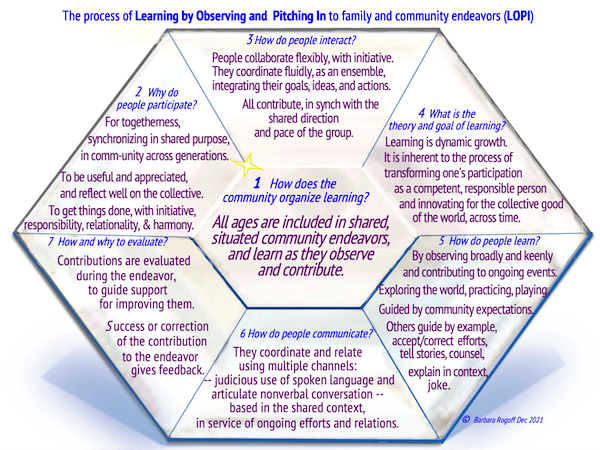Blog for Indigenous Ways of Learning
Posted by: Barbara Rogoff on September 29, 2022
Indigenous ways of learning provide inspiration for ways to transform learning in both informal and formal settings, to build on skills and practices that are highly valued and practiced in many Indigenous communities of the Americas.
A prominent example is the uptake of Native Hawaiian ways of organizing learning, especially through collaboration, which have made a large difference in conceptions of learning and efforts to foster it throughout schools and informal settings. Research on children’s collaboration in helping with household work led to innovations in the organization of schooling in the Kamehameha Early Education Program, and from there, spread internationally (partly through Tharp & Gallimore’s book, Rousing Minds to Life, 1988).
Indigenous scholars have for decades/centuries drawn attention to features of Indigenous ways of learning that are important in their communities (e.g., Cajete, 1994; Suina & Smolkin, 1994). For example, Oscar Kawagley (1995) drew attention to the importance of incorporating Indigenous elders’ knowledge in STEM learning in Alaska.
Key features of Indigenous ways of learning have been described as well by scholars such as Scribner and Cole (1973) and Greenfield and Lave (1982).
A consortium of researchers (many of them from Indigenous communities themselves) have been investigating Indigenous ways of learning in the Americas. Building on their research and the scholarship of Indigenous scholars and observers in Indigenous communities, they/we have identified some key features of the organization of learning (Correa-Chávez et al, 2015; Mejía-Arauz et al., 2022; Paradise & Rogoff, 2009; Rogoff et al., 2003, 2014).
The key features include collaboration, making a difference/giving back, intergenerational connection, responsibility, and respect. My colleagues and I refer to this way of organizing learning as Learning by Observing and Pitching In to family and community endeavors (LOPI; Rogoff & Mejía-Arauz, 2022; https://learningbyobservingandpitchingin.sites.ucsc.edu). Over the years of discussions in the consortium, we have created a model to describe this way of learning. It takes the form of a prism, to emphasize that the 7 features (facets) are integrated in a whole. One of the featured videos for the upcoming Theme of the Month event, “Learning by Observing and Pitching In,” provides illustrations of each of the 7 facets of the LOPI model.

The upcoming Theme of the Month expert panel webinar brings together three teams of researchers whose recent videos expand on these ways of learning:
Nuria Jaumot-Pascual and Tiffany Smith join the discussion from the team that created the video, “Portraits of Giving Back by Native Individuals in STEM,” which brings attention to the importance for learning of giving back to the community, of being able to contribute to the good of the community.
Zoe Higheagle Strong comes to the discussion from the team that produced the video, “Culturally Responsive Indigenous Science,” which emphasizes the importance of intergenerational relations, in several ways – the importance of learning from elders, and the essential value of the next generation’s learning for the continuation of the community itself.
Andrew Dayton represents the team that developed the video, “Learning to Collaborate and Collaborating to Learn,” which underlines the community value of collaboration, of pitching in together, helping each other. I’m part of that team, and I will also join with Andy’s comments.
The discussion in the upcoming Theme of the Month event will expand on these ideas. The goal is to deepen understanding of how Indigenous ways of learning matter for learning in Indigenous communities and provide wisdom for the benefit of other communities as well, in the aim of fostering the learning of STEM concepts and approaches. Please join us!
References:
Cajete, G. (1994). Look to the mountain: An ecology of Indigenous education. Kivaki Press.
Correa-Chávez, M., Mejía-Arauz, R., & Rogoff, B. (2015). (Eds.) Children learn by observing and contributing to family and community endeavors: A cultural paradigm. Vol. 49 of Advances in Child Development and Behavior.
Greenfield, P.M., & Lave, J. (1982). Cognitive aspects of formal and informal education. In D. Wagner & H. Stevenson (Eds.), Cultural perspectives on child development, pp. 181-207. Freeman.
Kawagley, A. O. (1995). The Yupiaq worldview: A pathway to ecology and spirit. Waveland Press.
Mejía-Arauz, R., Rogoff, B., & Dexter, A.L. (Eds.) (2022). Learning as a community process of observing and pitching in. [Aprender como un proceso comunitario de observar y acomedirse.] Special issue of Journal for the Study of Education and Development / Infancia y Aprendizaje (Vol. 45:3). https://doi.org/10.1080/02103702.2022.2086770
Paradise, R., & Rogoff, B. (2009). Side by side: Learning through observing and pitching in. Ethos, 37, 102-138. https://doi.org/10.1111/j.1548-1352.2009.01033.x
Rogoff, B., Alcalá, L., Coppens, A.D., López, A., Ruvalcaba, O., & Silva, K.G. (2014) (Guest Eds.), Learning by Observing and Pitching In to family and community endeavors. Special Issue, Human Development, 57.
Rogoff, B., & Mejía-Arauz, R. (2022). The key role of community in Learning by Observing and Pitching In to family and community endeavors. Journal for the Study of Education and Development, 45(3), 494-548. https://doi.org/10.1080/02103702.2022.2086770
Rogoff, B., Paradise, R., Mejía-Arauz, R., Correa-Chávez, M., & Angelillo, C. (2003). Firsthand learning through intent participation. Annual Review of Psychology, 54(1), 175–203. https://doi.org/10.1146/annurev.psych.54.101601.145118
Scribner, S., & Cole, M. (1973). Cognitive consequences of formal and informal education. Science, 182, 553-59. https://www.science.org/doi/10.1126/science.182.4112.553
Suina, J.H. & Smolkin, L.B. (1994). From natal culture to school culture to dominant society culture. In P.M. Greenfield & R.R. Cocking (Eds.), Cross-cultural roots of minority child development (pp. 115-130). Erlbaum.
Tharp, R., & Gallimore, R. (1988). Rousing minds to life. Cambridge University Press. https://doi.org/10.1017/CBO9781139173698
